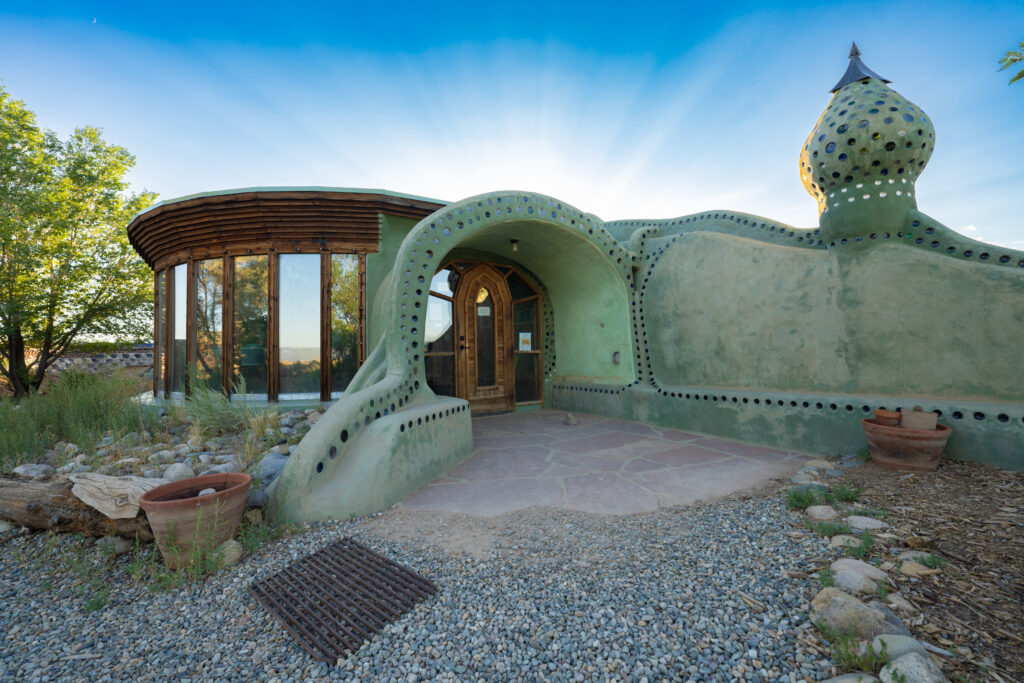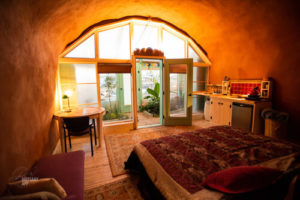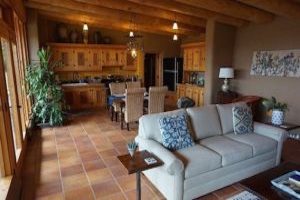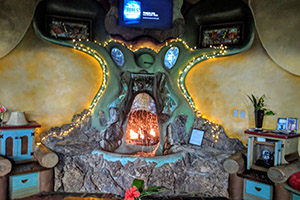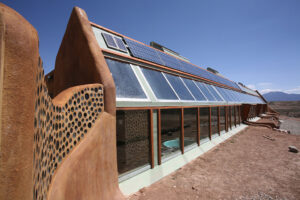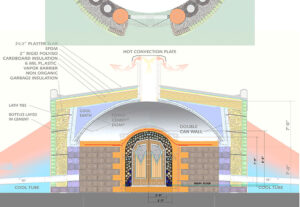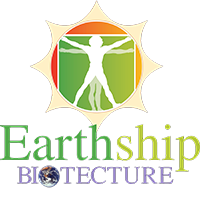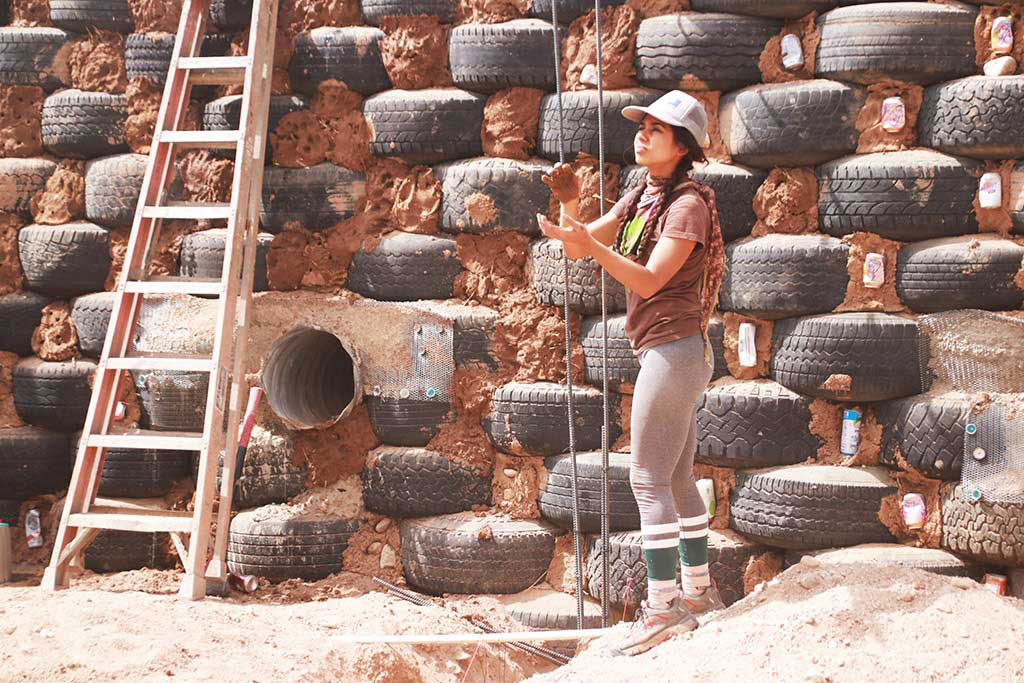 MBEP’s climate change initiative lead, Ashley Gauer, learns how to build an Earthship
MBEP’s climate change initiative lead, Ashley Gauer, learns how to build an Earthship
Under any circumstances, pounding metal support rods, ramming dirt into old tires and digging trenches would be physically demanding. The dry, blazing heat of a New Mexico sun, with temperatures that can hover near triple digits, can turn the work into a test of body and spirit.
For MBEP’s special project manager and lead on MBEP’s climate initiative, Ashley Gauer, who recently spent a month building an Earthship in the desert, “It was a transformative and humbling experience, “ said Gauer. “I am inspired by out-of-the-box solutions, bold ideas and substantive actions. The lessons of a sustainable approach to building self-contained, living, breathing homes hold promise for the Monterey Bay region and beyond.”
But what is an Earthship and why should we care?
The Earthship concept is a bold vision of architect Michael Reynolds. His sustainable architecture firm, Earthship Biotecture, designs off-the-grid, closed-loop structures that harvest their own water and power, produce their own food, and contain and treat their own sewage.
When Reynolds, a proponent of “radically sustainable living,” built his first Earthship out of salvaged steel beer and soda cans in 1972, reactions largely ranged from bemused to befuddled. These days, the premises on which he builds structures — self-sustaining systems that create environmental solutions rather than negatively impacting the environment — are far less easily dismissed. Thousands of self-reliant Earthships now exist around the world, including a community center in Puerto Rico built in response to the devastation of Hurricane Maria.
Pounding repurposed tires for thermal mass and insulation
Gauer, along with a team of other volunteers — most of whom had no prior construction experience — recently spent several weeks turning old tires and a combination of natural and repurposed materials into a two-bedroom house that stays naturally climate controlled even in high-desert temperature extremes. In addition to pounding repurposed tires for thermal mass and insulation, Gauer and her team learned to make adobe, mortar and cement for plastering and canning walls, install cisterns and vents for water storage and natural convection, dig planter beds, construct window frames, and lay out a closed-loop plumbing system for an embedded greenhouse and food production using graywater.
“Reynolds’ approach holds concepts worth reflection.” says Gauer “The community and team-building that fuels each project, the awareness that each choice in how we build and what we consume has an impact on the environment and ultimately our very lives, the investment of sweat equity and the notion of ‘slow building’, with its parallels to the slow food and fashion movement, makes it a shared and lived experience that’s truly special.”
Those are things that Gauer does every day as she works with MBEP member organizations in the areas of energy efficiency, recycling and reuse, sustainable and transit-oriented development and climate action advocacy, and she’s committed to bringing new ideas to the table that could benefit our region.
As coastal communities look to grapple with sea level rise, flood risks, salt water intrusion into aquifers, longer and more extreme fire seasons, and other climate impacts that are rapidly becoming less hypothetical, we need to challenge ourselves to embrace bold change and see the world in new ways.
Six years ago, Gauer participated in the company’s Academy, a three-part program designed to share the theory, systems and principles of Earthships. That’s later followed with a field experience and independent study where participants propose and execute a project of their own. Which is how Gauer’s path led her to Reynolds’ Earthship community to gain first-hand experience with his building methods.
Sustainable building techniques continue to gain traction, as the built environment’s role in increasing or reducing carbon emissions becomes increasingly clear. Given their versatility and reliance on readily available materials, including much which would otherwise be bound for the landfill, Gauer sees Earthships as yet another innovative, green building design that can cover all of our main physical needs and can be built just about anywhere in the world, including drought and fire-prone areas.
Advocating for systemic, actionable change
“How we spend our dollar, how we build, etc. is a voting mechanism for the kind of world in which we want to live,” says Gauer. “The main takeaway is we have an opportunity to vote every day. We can, individually and collectively, make radical incremental change. We can choose to be more open to exploring wild ideas or ideas we’ve just never experimented with that are meant to enrich our lives and communities while deepening our connection to our planet in a positive, meaningful and holistic way.”
Gauer would like to see the region’s sectors collaborate on an experimental demonstration site for green building pilots, prototypes and education including retrofitting and weatherizing existing buildings, not just new ones.
“It wasn’t until I discovered Earthships that I realized our buildings are living entities that can either reduce or increase our emissions, that we can understand where our power and water come from, how much of it we need, where our sewage goes,” says Gauer, “How much of it we can actually reuse to grow food and landscape our yards, and actually contribute to our environment and neighbors in a positive sustainable way; that we live in a world profuse of waste, which can be repurposed to build creatively and synchronistically with nature…. All of this, ultimately impacts the overall quality of our lives. Period. We’re completely interwoven and interconnected. This is the revelation. This is the call…until we ‘get it’, I have grave concern for my generation and the next and the next and the next, but I remain hopeful, that as a human race, we have an immense ability to recover, reinvent and rebuild.
We have to start small, somewhere. There are lots of great people and organizations already making sustainable architecture, infrastructure and planning a priority. It’s about finding one another, collaborating and advocating for systemic, actionable change. This is why MBEP is so unique: We’re open to having these kinds of conversations, and poised to plant the seed.”
This article originally appeared at mbep.biz – Monterey Bay Economic Partnership (MBEP) is a regional member-supported nonprofit organization consisting of public, private and civic entities located throughout the counties of Monterey, San Benito and Santa Cruz. Founded in 2015, our mission is to improve the economic health and quality of life in the region.

